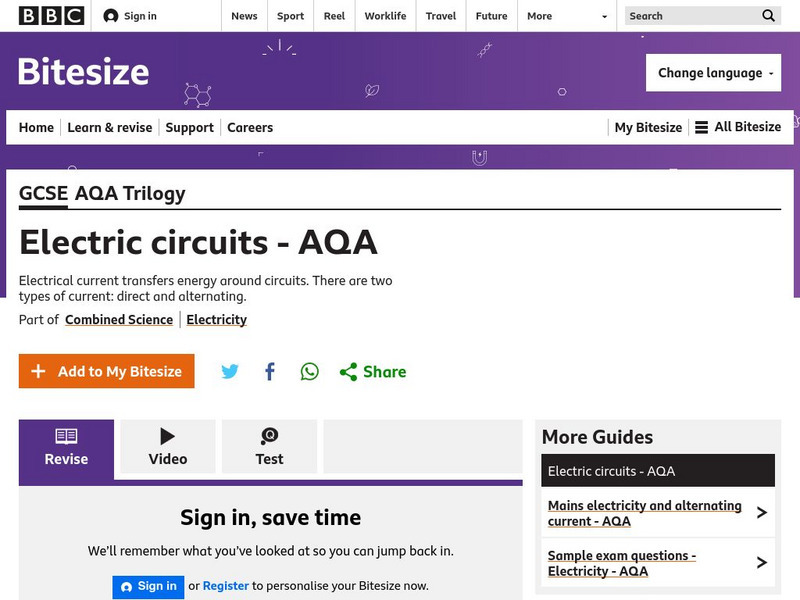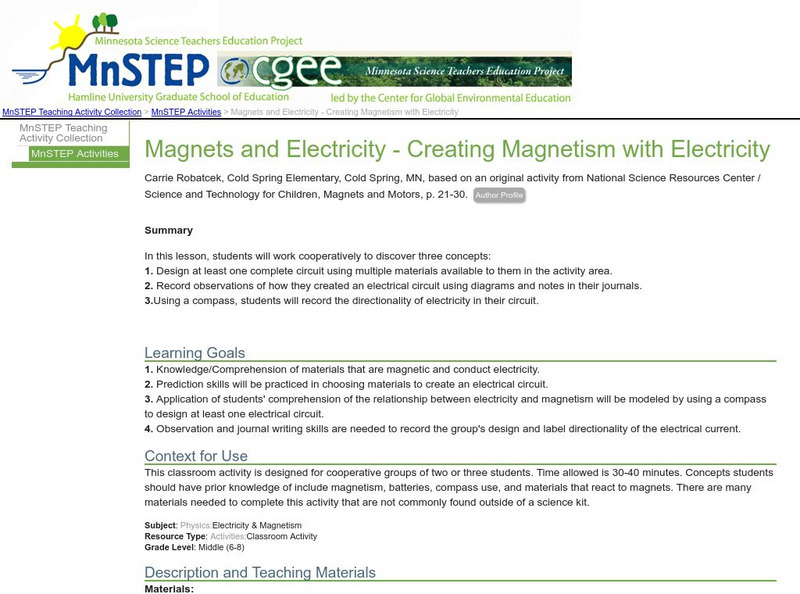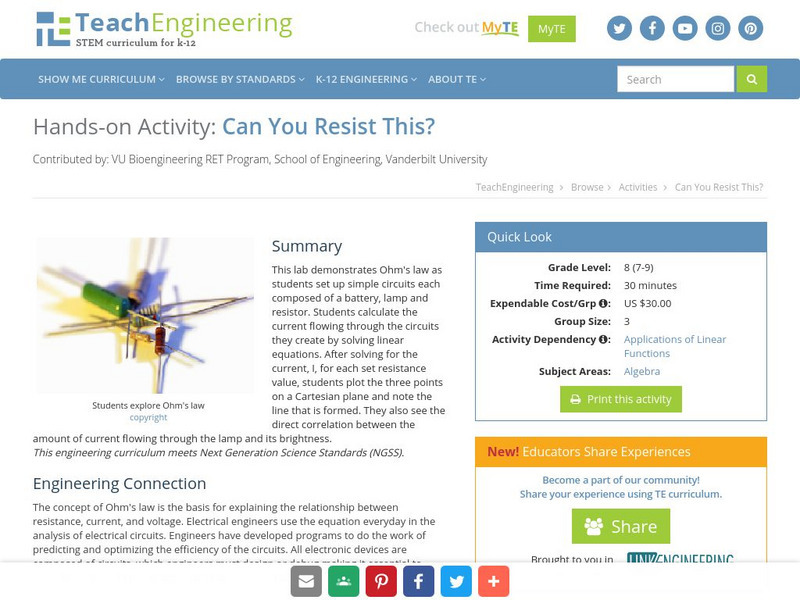Hi, what do you want to do?
Physics Classroom
The Physics Classroom: What Is an Electric Circuit?
In this tutorial the concept of electric potential difference is discussed. Electric potential is the amount of electric potential energy per unit of charge that would be possessed by a charged object if placed within an electric field...
TryEngineering
Try Engineering: Electric Switches
Lesson focuses on how switches control the flow of electricity. Students are posed with the challenge of designing and building a simple switch into an electric circuit.
CK-12 Foundation
Ck 12: Physics Simulation: Electric Motor
[Free Registration/Login Required] Learn how magnetic forces acting on current-carrying wires can be used to drive an electric motor using this interactive simulation. A PDF worksheet and a video tutorial are also available. [2:47]
Khan Academy
Khan Academy: Electrical Engineering: Circuit Analysis
Circuit analysis is the process of finding all the currents and voltages in a network of connected components. We look at the basic elements used to build circuits, and find out what happens when elements are connected together into a...
BBC
Bbc: Gcse Bitesize: Electric Circuits Aqa
This lesson focuses on Electrical circuits including standard symbols for electrical components, a list of components and what they do, a discussion of various types of resistors, and alternating current and direct current. Links to a...
Other
Easyphysics: Chapter 13 Current Electricity
Learners investigate current electricity. Some topics examined are voltage law, Ohm?s law, and electric resistance. The resource includes example problems with solutions and a chapter quiz.
Physics Aviary
Physics Aviary: Induced Current Lab
This lab was designed to have students test the factors that determine how much current is induced in a circuit when area of the circuit is changed. This lab is a quantitive lab that supplements the lab on magnetic flux.
Science Education Resource Center at Carleton College
Serc: Magnets and Electricity: Creating Magnetism With Electricity
Students will work in small groups to design at least one complete circuit using multiple materials. They will record their observations of how they created an electrical circuit using diagrams and notes in their journals. Using a...
Better Lesson
Better Lesson: The Lightbulb Just Went On!
Fourth graders discover how electricity can be converted to light energy.
Science Education Resource Center at Carleton College
Serc: Electric Circuits Guided Inquiry
An electrical circuit guided inquiry where learners investigate what an electric circuit is, the main parts of a circuit and the difference between series and parallel circuits. Students groups create a circuit using materials provided...
Other
Need: Measuring Electricity [Pdf]
This site details many of the ways in which to measure electricity. Among the topics covered by this page is resistance and voltage as well as electrical energy and Ohm's Law.
E-learning for Kids
E Learning for Kids: Science: Greece: What Can Electricity Do?
Alex is an actor in a play. Help him figure out which items use electricity so he can make sure everything is ready for the play.
University of Kentucky
Virtual Workshop: The Course on Electricity & Magnetism
On line course on Electricity and Magnetism for graduate credit or professional development, that emphasizes hands on activities you can use in your classroom.
Science Education Resource Center at Carleton College
Serc: Investigating Testing for Electrical Conductivity Using Materials
In this activity, students will understand that electricity moves through different circuits and discover what types of materials are conductors and insulators.
Concord Consortium
Concord Consortium: Measuring Current in Parallel Circuits
When measuring the current in parallel circuits, compare the circuit's total current with the current through just one resistor.
Concord Consortium
Concord Consortium: Measuring Current on a Breadboard
Find out how measuring current in a circuit is like measuring the flow rate of water in a sprinkler system.
Concord Consortium
Concord Consortium: Calculating Current in Series Parallel Circuits
Use resistance formulas to determine the total resistances of the series and parallel parts. Then, use Ohm's Law to calculate the voltage drops across and currents through each part.
TeachEngineering
Teach Engineering: Potato Power
Students use potatoes to light an LED clock (or light bulb) as they learn how a battery works in a simple circuit and how chemical energy changes to electrical energy. As they learn more about electrical energy, they better understand...
TeachEngineering
Teach Engineering: Can You Resist This?
This lab demonstrates Ohm's law as students set up simple circuits each composed of a battery, lamp and resistor. Students calculate the current flowing through the circuits they create by solving linear equations. After solving for the...
PBS
Pbs Kids:activities and Videos: Electricity
This PBS site offers videos and activities are hands-on challenges that focus on the engineering design process. They use simple materials, allow for multiple solutions, and are ideal for ages 9-12.
Science Education Resource Center at Carleton College
Serc: Ph Et Simulations: Replace Real Equipment in Lab Circuit Construction Kit
Students explore with a PhET interactive simulation to replicate the construction of electrical circuits.
Utah Education Network
Uen: Flowing Electrons
For this fifth grade activity, students explore electric circuits by acting out different types, then construct circuits themselves.
Physics4kids
Physics4 Kids: Electricity and Magnetism: Current
Explains electric current, how it produces heat, and the difference between a direct current and an alternating current.
Science Struck
Science Struck: Difference Between Alternating and Direct Current
Explains what alternating current and direct current are and what they are used for.
Other popular searches
- Current Electricity
- Static and Current Electricity
- Bill Nye Current Electricity
- Current Electricity Test
- Current Electricity Power
- Current Electricity Review
- Static or Current Electricity
- Statc or Current Electricity
- Static Electricity Current






















